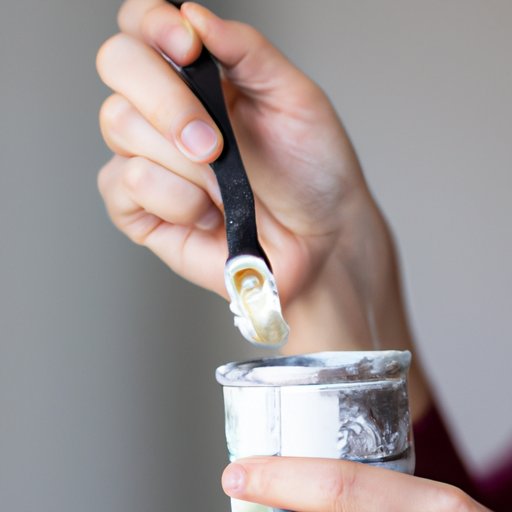
I. Introduction
Caulk is an essential sealant used around windows, bathtubs, showers, and sinks to keep moisture at bay. The problem with this commonly used sealant is that it wears out over time, leading to leaks and other issues. Removing caulk can be a real challenge, but with the right tools and techniques, it can be a straightforward process.
It’s essential to know how to remove caulk because neglecting damaged or worn-out caulk can lead to significant issues in your home. These issues range from moisture damage to increased energy bills. Knowing how to remove caulk is an essential skill that every homeowner should have. This article presents a comprehensive guide to removing caulk to help you get the job done right.
II. Step-by-Step Guide to Remove Caulk
Before getting started, you will need to gather some essential tools. These tools include a utility knife, plastic scraper, caulk remover, mineral spirits, and safety goggles. Ensure that you wear protective clothing and gloves while working with caulk to avoid harmful chemicals and cuts. Here are the steps you should follow when removing caulk:
- Start by preparing the caulk for removal: To do this, you must score the caulk using a utility knife. Make parallel cuts to the surface or edge of the caulk, avoiding cutting the surface underneath the caulk.
- Use a plastic scraper to lift the edges: Gently lift the edges of the caulk using a plastic scraper. This step is important because it makes it easier to remove the bulk of the caulk.
- Apply caulk remover: Apply caulk remover over the caulk and let it work for the prescribed period. This step is crucial in breaking down the sealant and making it more comfortable to remove.
- Remove the caulk: After the caulk softens, remove it using a scraper. Use a utility knife to cut through stubborn parts of the caulk. For better results, use mineral spirits to remove any remaining residue.
III. Chemical-Based Methods of Removing Caulk
If using a scraper and caulk remover seems like too much work, chemical-based methods of removing caulk may be for you. Some of the best caulk removers in the market include Goo Gone, 3M Caulk Remover, and DAP Caulk Remover. The benefits of using chemical-based removers include:
- Fast-acting: chemical removers make the removal process quicker than other methods.
- Effective: professionals use chemical-based removers because they are efficient and reliable.
- Easy to use: With chemicals, you can eliminate the need for cutting or scraping, reducing any damage risks.
However, you must take precautions. Chemicals can be harmful to your health and your property. You must read the manufacturer’s instructions and use protective gear at all times.
IV. Natural Alternatives for Removing Caulk
If you prefer to avoid chemicals, natural and eco-friendly solutions are available. These include vinegar, baking soda, and rubbing alcohol. These substances are readily available in most homes and work well in removing caulk. Here’s how you can use natural alternatives to remove caulk:
- Vinegar: Heat up some vinegar and apply it to the caulk-sealed area. Allow it to sit for a few minutes, then use a scraper or a utility knife to remove the caulk.
- Baking Soda: Mix baking soda with water to form a paste. Apply the paste on the caulk and let it sit for some time. Use a scraper to remove the paste and caulk residue.
- Rubbing Alcohol: Apply rubbing alcohol over the caulk, wait for a few minutes, then scrape off the caulk.
V. Pros and Cons of Different Caulk Removal Methods
There are different ways of removing caulk, each with its advantages and disadvantages. Here are some pros and cons to consider before deciding:
- Chemical-based methods: Pros: Fast-acting and effective. Cons: Chemicals can be harmful to you and your property.
- Scraping: Pros: Affordable and easy to do. Cons: Time-consuming and labor-intensive.
- Natural alternatives: Pros: Eco-friendly and readily available. Cons: Time-consuming and may not remove all caulk.
VI. Cost-Effective Options for Caulk Removal
Removing caulk can be costly if you hire professionals or purchase chemical caulk removers. Luckily, there are DIY solutions that only require materials readily available in most homes. These include:
- Scraping: Use a scraper to remove the caulk. This method requires no additional materials.
- Vinegar: Vinegar is an affordable and readily available solution that works well in breaking down caulk.
- Baking Soda: Baking soda is also affordable and readily available. It works well in removing residue left behind after scraping.
When removing caulk, you want to make sure you are using a cost-effective method to avoid overspending.
VII. Discussion of Common Mistakes when Removing Caulk
Removing caulk is not always easy. Mistakes can happen, leading to damage or unsatisfactory results. Here are common mistakes to be on the lookout for:
- Trying to remove caulk all at once: Removing caulk is a process that must be done step by step; otherwise, you may damage the surface underneath the caulk.
- Using too much force: Using excessive force when scraping or cutting may lead to damage on surrounding surfaces.
- Not using protective gear: Always wear protective clothing and goggles when handling chemicals or sharp tools.
By avoiding these mistakes, you increase your chances of success when removing the caulk. If you make a mistake, take the necessary steps to rectify it.
VIII. Conclusion
Removing caulk need not be a costly or stressful task. By following the methods outlined in this article, you can easily remove caulk using affordable and readily available materials. It’s essential to remember to use protective gear when handling chemicals or sharp tools, and to avoid common mistakes that can lead to unsatisfactory results. Knowing how to remove caulk is an essential skill for every homeowner, and we encourage you to practice the most appropriate and effective removal methods for best results.




